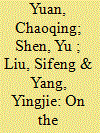|
|
|
Sort Order |
|
|
|
Items / Page
|
|
|
|
|
|
|
| Srl | Item |
| 1 |
ID:
147494


|
|
|
|
|
| Summary/Abstract |
As the most knowledge-intensive industrial sectors, China’s defense industries are developing very fast. The present paper will explore the contribution of China’s defense innovation to its economic growth. Cobb–Douglas production function, integrating defense and non-defense stock in knowledge, is applied during the course. In addition, an input–output analysis of defense equipment procurement was done. Positive effect of China’s defense innovation on economic growth has been revealed by comparing the results from the two methods. And some suggestions are made to strengthen the effect.
|
|
|
|
|
|
|
|
|
|
|
|
|
|
|
|
| 2 |
ID:
098605


|
|
|
|
|
| Publication |
2010.
|
| Summary/Abstract |
Since the 1980s, Chinese economy grew rapidly. With the rapid economic growth, Chinese energy consumption sharply increased. The relation between Chinese energy consumption and economic growth is focused on, and many researchers have studied this issue by applying the methods such as granger causality test. However, the results just reveal the relation in a very long period. In this paper, the history of Chinese economy is divided into four periods. And the relation between Chinese energy consumption and economic growth is examined by applying grey incidence analysis, which is one of the most important methods of grey system theory which can be applied to solve the problems with small samples. The results show that the relations in different periods are not the same. The degree of grey incidences between total energy consumption and values added of secondary industry is larger, and the degree of grey incidences between GDP and consumption of coal is larger too. And the policy implications of these results are explained.
|
|
|
|
|
|
|
|
|
|
|
|
|
|
|
|
| 3 |
ID:
093486


|
|
|
|
|
| Publication |
2010.
|
| Summary/Abstract |
The pricing mechanism for energy is not in line with the international standards, because the energy prices are controlled by the government partly or completely in China. Chinese government made a lot of efforts to improve the pricing mechanism for energy. The relations between Chinese energy prices and energy consumption are the foundations to reform the mechanism. In this paper, the relations between Chinese energy consumption and energy prices are researched by cointegration equations, impulse response functions, granger causality and variance decomposition. The cointegration relations among energy prices, energy consumption and economic outputs show that higher energy price will decrease energy consumption in Chinese industrial sectors but will not reduce the economic output in the long run. The cointegration relation between energy price and household energy consumption shows that higher energy price will decrease household energy consumption in the long run and increase it in the short run. So Chinese government should deepen the reform of pricing mechanism for energy, and increase the energy prices reasonably to save energy.
|
|
|
|
|
|
|
|
|
|
|
|
|
|
|
|
| 4 |
ID:
088947


|
|
|
|
|
| Publication |
2009.
|
| Summary/Abstract |
Energy issues receive more and more attention these days. And it is considered that technological progress is an essential approach to save energy. This essay is to analyze the relation between energy intensity and technological progress by Cobb-Douglas production function in which energy, labor, capital and technological progress are taken as independent variables. It proves that the growth of output per capital and output per labor will increase energy intensity while technological progress will decrease energy intensity. Empirical research on Chinese industry is used here to indicate technological progress greatly decreases energy intensity. Because of the interferences of Asian financial crisis, there is something abnormal in the data. So in the empirical research, average weaken buffer operator (ABWO) is applied to weaken the interference of Asian financial crisis to the fixed assets, energy and value added. The results of the empirical research show that technological progress decreases energy intensity of Chinese industry an average of 6.3% every year in China.
|
|
|
|
|
|
|
|
|
|
|
|
|
|
|
|
| 5 |
ID:
088243


|
|
|
|
|
| Publication |
2009.
|
| Summary/Abstract |
This paper summarizes the main energy policies of China from 1980, and divides them into three groups of policies. Two methods, with and without antitheses and linear regression, are created to evaluate the energy-saving effects of the energy policies. And the energy-saving effects of these three groups of energy policies of China are evaluated by the two methods, respectively. It is concluded that with and without antitheses is used to evaluate short-term effects and linear regression is used to evaluate long-term effects.
|
|
|
|
|
|
|
|
|
|
|
|
|
|
|
|
|
|
|
|
|